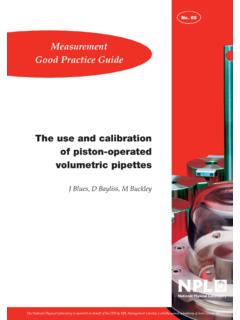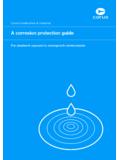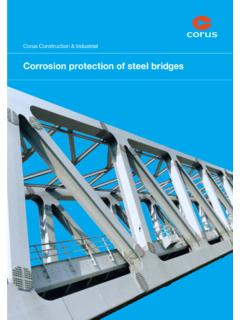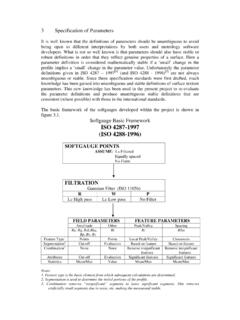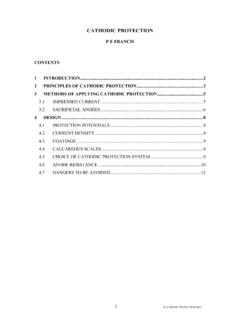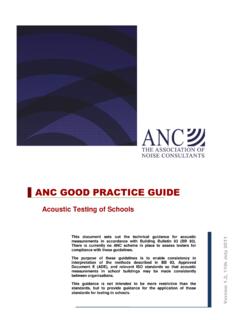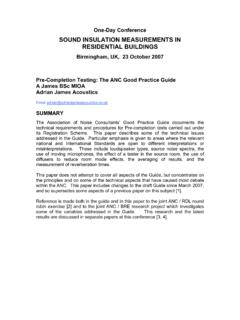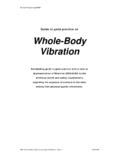Transcription of Measurement Good Practice Guide
1 The National Physical Laboratory is operated on behalf of the DTI by NPL Management Limited, a wholly owned subsidiary of Serco Group plcThe Measurement ofMass and WeightS Davidson, M Perkin, M BuckleyMeasurement good Practice GuideNo. 71 Measurement good Practice Guide No. 71 The Measurement of Mass and Weight Stuart Davidson, Michael Perkin Division of Engineering and Process Control National Physical Laboratory Mike Buckley South Yorkshire Trading Standards Unit Abstract: This good Practice Guide is intended as a useful reference for those involved in the practical Measurement of mass and weight.
2 Crown Copyright 2004 Reproduced by permission of the Controller of HMSO ISSN 1368-6550 June 2004 National Physical Laboratory Teddington, Middlesex, United Kingdom, TW11 0LW Website: Acknowledgements The authors acknowledge the financial support of the National Measurement System Directorate of the UK Department of Trade and Industry. The Measurement of Mass and Weight Contents 1 Introduction ..1 2 Surface condition ..2 Magnetism ..2 Weight cleaning.
3 2 Weight handling ..3 Gloves ..3 Tweezers ..3 Clean Weight storage ..4 3 Weighing techniques ..4 Direct reading measurements ..4 Weighing by Substitution weighing ..6 ABA ABBA calibration ..7 Cyclic weighing ..7 Weighing by Make-weights ..9 4 Air density Measurement and buoyancy correction.
4 9 True Conventional Buoyancy The application of buoyancy Determination of air density from parametric measurements ..12 5 Balance assessment ..12 Balance location ..13 Measurement Two-pan balances ..13 Single-pan mechanical balances ..14 Single-pan electronic balances ..14 Assessment of two pan balances.
5 14 Routine periodic Rider weight ..14 Internal balance weights ..15 Linearity of scale ..15 Sensitivity ..15 Repeatability of Repeatability of Measurement ..15 Assessment of mechanical single pan Visual inspection and mechanical check ..16 Drift ..16 Calibration of internal weights ..16 Effect of off centre loading (eccentricity) ..16 Scale sensitivity (scale value)..17 Scale linearity ..17 Repeatability of Repeatability of Measurement .
6 17 Assessment of electronic balances ..17 Effect of off centre loading (eccentricity) ..18 Scale error and Repeatability of Repeatability of Measurement ..19 6 Uncertainty in mass Introduction ..19 The The uncertainty budget ..20 Sources of uncertainty ..20 Values ..21 Probability distributions ..21 Divisor ..23 Sensitivity coefficient (ci)..23 Standard uncertainty in units of measurand, ui(Wi).
7 23 Degrees of freedom Adding it all up ..24 Air buoyancy uncertainty budget ..25 Reporting the results ..27 7 References ..28 Measurement good Practice Guide No. 71 1 The kilogram (kg) is the unit of mass; it is equal to the mass of the international prototype of the kilogram. 1 Introduction The unit of mass, the kilogram, remains the only base unit in the International System of Units (SI), which is still defined in terms of a physical artefact. Its definition is: The difference between mass and weight is that mass is a measure of the amount of material in an object, weight is the gravitational force acting on a body.
8 However, for trading purposes weight is often taken to mean the same as mass. The international prototype of the kilogram is kept at BIPM, the International Bureau of Weights and Measures in S vres, Paris. It consists of an alloy of 90% platinum and 10% iridium in the form of a cylinder, 39 mm high and 39 mm in diameter. It is stored at atmospheric pressure in a specially designed triple bell-jar. About 60 countries hold platinum-iridium alloy copies of the BIPM kilogram (K), whose values have been determined directly from K.
9 The National Physical Laboratory (NPL) holds the UK copy (No. 18), which is referred to as the national prototype kilogram, or simply kilogram 18 and is the basis of the entire mass scale in the UK. The NPL participates in a wide range of international comparisons to ensure that measurements made in the UK are equivalent to those made elsewhere in the world. In the past there have been some problems with organisations based in one country not accepting traceability to any NMI other than their own.
10 This situation has been addressed with the advent of a structured approach to international equivalence via a Mutual Recognition Agreement (MRA) and regular international Measurement comparisons. The use of appropriate mass standards and their correct treatment at all times is essential to mass metrology. Weights are divided into classes from high quality reference standards (Class E1) to those used in industrial settings (Class M3). These classes were originally specified for legal metrology purposes, but they are now in common usage throughout mass Measurement .
